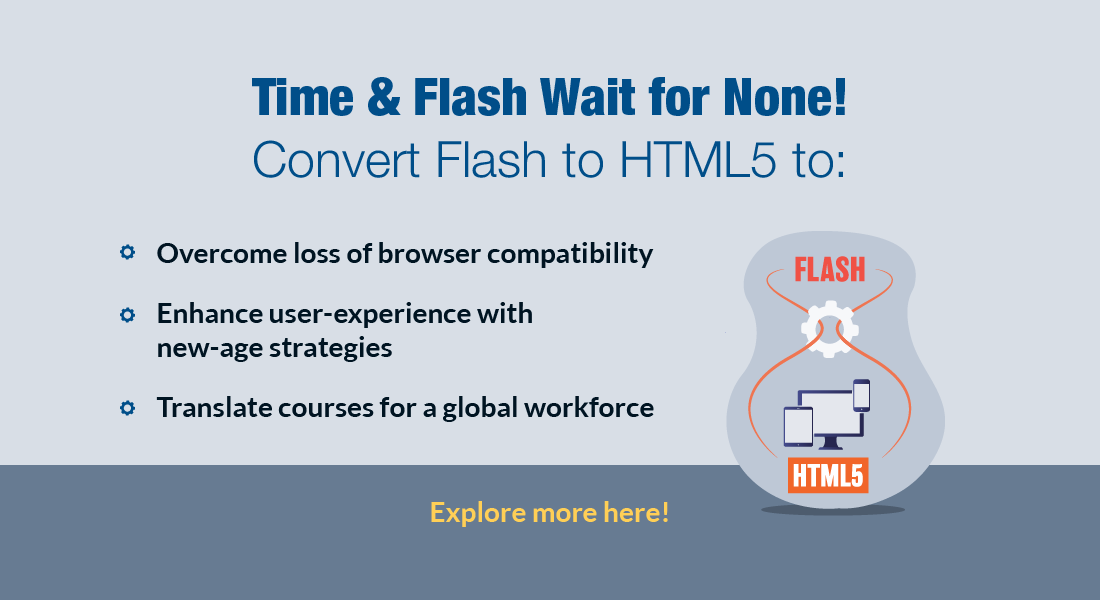5 Compelling Reasons for Flash to HTML5 Conversion

Life grows short as the hours draw close.
Such is the case for Adobe Flash reaching its end in December this year! And that spells the potential death of the scores of eLearning courses that have been developed with Flash over time for organizations far and wide. Fortunately, the host of features, benefits, and versatility of HTML5 has made it a more than worthy successor to Flash. Flash to HTML5 conversion has become the new buzzword in the eLearning industry, and the go-to strategy for eLearning designers and developers, as well as training managers like you who are intent on preserving and restoring their eLearning courses.
Flash to HTML5 Conversion – 5 Reasons to Do It ASAP
- Adobe is ending support for Flash in December 2020
- Flash courses aren’t mobile-compatible
- Interactivities can be updated, enhanced
- Courses without source files can be salvaged
- Courses can be translated into multiple languages
Explore the ultimate guide on Flash to HTML5 conversion strategies for eLearning courses.
But why is HTML5 so popular and why is it the perfect replacement for Flash? Let’s find out, shall we? Continue reading this blog for the five reasons why the golden hour for Flash to HTML5 conversion is now.
For years since its inception, Adobe Flash has been on the frontline of developing interactive web content and small games, known popularly as Rich Internet Applications. But playing Flash content on the web required downloading additional plugins. Later, as open standards like HTML5 and WebGL advanced to provide the same functionality without the extra plugins, the usage of Flash started going down. In fact, according to a Chromium report on Flash usage trends, there has been a reduction in the use of Flash from 2014 to 2019.
HTML5 slowly overtook Flash to be the frontrunner of Web application development, becoming an instant favorite of eLearning course developers. Here are five compelling reasons why Flash to HTML5 conversion should be at the top of your to-do list.
Why Flash to HTML5 Conversion is a Priority in Corporate Training
1. End of Support for Flash
This should probably be the most compelling reason to consider Flash to HTML5 conversion. Back in 2010, Apple pulled the plug on Flash support in their devices, and in 2017 Adobe finally announced the EOL for Flash. But what does that mean and why is it relevant?
First, Adobe Flash was incompatible with most mobile devices, which was a terrible handicap considering the way people are using mobile devices. This issue spilled over to the touchscreen domain as Flash was not made for touch compatibility. Besides, Flash had major issues with security and users complained of malware attacks by hackers.
For a 21st century corporate learner relying on virtual training and eLearning for training, Flash has become outdated and does not serve the intended functions well. HTML5 on the other hand comes out as the stronger opponent, not only by being more secure than Flash, but also because of its multi-device compatibility, touch-friendliness, and better overall performance support across all devices.
2. Mobile-Friendliness
One of the most popular learning strategies of the 21st century is mobile learning which enables learners to access all their eLearning on a handheld device. As I’ve stated before, Flash’s inability to support web content for mobile devices was a huge blow for trainers and learners alike. HTML5 offers a responsive output, which means that courses will adapt to the screen size, resolution, and orientation of whatever smartphone or tablet they are being accessed through, regardless of which platform it was developed on. Remember, Flash courses were predominantly designed for PCs.
Being mobile friendly has a lot of advantages. Learners can access learning resources anywhere and anytime they want to. This allows for more efficient self-paced learning. However, being responsive does not only mean adjusting to the screen real estate, but also offering features like swipe, zoom, taps, and other gestures which really make mobile learning live up to its name. Remember when Flash offered the same features? Yeah, me neither.
3. Updated Interactivities
Interactivities in eLearning mean better retention of learning, and nothing utilizes interactivities in eLearning courses better than HTML5. Updating mobile-friendly interactivities in your eLearning courses includes both addition and deletion. Flash was a code-heavy software. Because Flash could create complex interactivities, old legacy courses were very decorative, even when not necessary. As you carry out Flash to HTML5 conversion, you’ll see modern rapid authoring tools can replicate these interactivities in HTML5 easily while retaining a minimalistic design.
This is where rapid authoring tools come in to make the interactivities more relevant and intuitive. Authoring tools like Articulate Storyline have in-built triggers, dials, and sliders which help create interactivities that reflect the ones in the original Flash-based courses. Adding interactivities using authoring tools is much simpler because not only do they not require coding, they also come with pre-built templates. Rapid authoring tools like Adobe Captivate, Lectora Inspire, dominKnow and iSpring, all output the final product in an HTML5-compatible format.
4. Retain Courses with No Source Files
One of the major hurdles on your path to conversion may be the lack of availability of source files for older Flash-based courses. While some may not have source files at all, others might have source files that are unusable. Fret not. If you feel these courses are essential for training and need to be retained, the ’Record strategy’ can be your friend. Here, the course is played and recorded using a screen capture tool (such as Camtasia), and the output is the HTML5 compatible MP4 format. Of course, a Record conversion strategy will work specifically for courses that involve low level learning and recall, and have no interactivities.
If legacy courses do not have source files, but have most of the media elements intact, the course can be redesigned. This also allows you to enhance the user experience of the courses. What’s even better? While revising and updating content, you can also cut down redundant bits of information, update information in older courses, and break lengthy courses into smaller microlearning units, which are more in line with the present day learner and mobile learning.
Psst! Check out the 4 ‘R’s of Flash to HTML5 conversion for an added incentive behind Flash to HTML5 conversion.
5. Multilingual Translation
Global corporations entail a global outreach. Yet translating Flash-based courses has always been a tedious process, often to non-native learners’ disadvantage. With HTML5 conversion, executing multilingual eLearning translations has become only slightly less than a cakewalk.
Most authoring tools come with features that support translation requirements. The translation tool facilitates exporting translatable content to an RTF file, which can be translated to any language by an eLearning translations vendor. It is always advisable to have a single translation partner, given that you will be translating several aspects of the course like text, audio scripts, and subtitles. A single translation partner can better ensure the process is streamlined.
Authoring tools ease the process of publishing courses tomultiple languages too. Lectora for instance, has a multilingual publishing option where one course can be published in multiple languages. Learners can access the course in the language of their choice. Articulate Storyline comes with a Text Label feature by which the buttons, messages and other on-screen components can be localized for a specific geography. Speaking of geography, Adobe Captivate boasts of a geolocation feature which allows you to create and publish courses and assessments only for a specific geographical location.
Wrapping it Up!
HTML5 is a robust alternative to Adobe Flash. Even if the above reasons are kept aside, it still comes out as the stronger variable simply because of the lack of additional plugins, versatile web and platform support, and most importantly, by not being a proprietary development tool. Besides, the growing number of mobile users around the world calls for a more responsive eLearning course development that complements the needs and expected outcomes of a 21st century corporate learner.
Want to explore Flash to HTML5 conversion even better? Here is a resourceful eBook on Flash to HTML5 conversion to consider.





